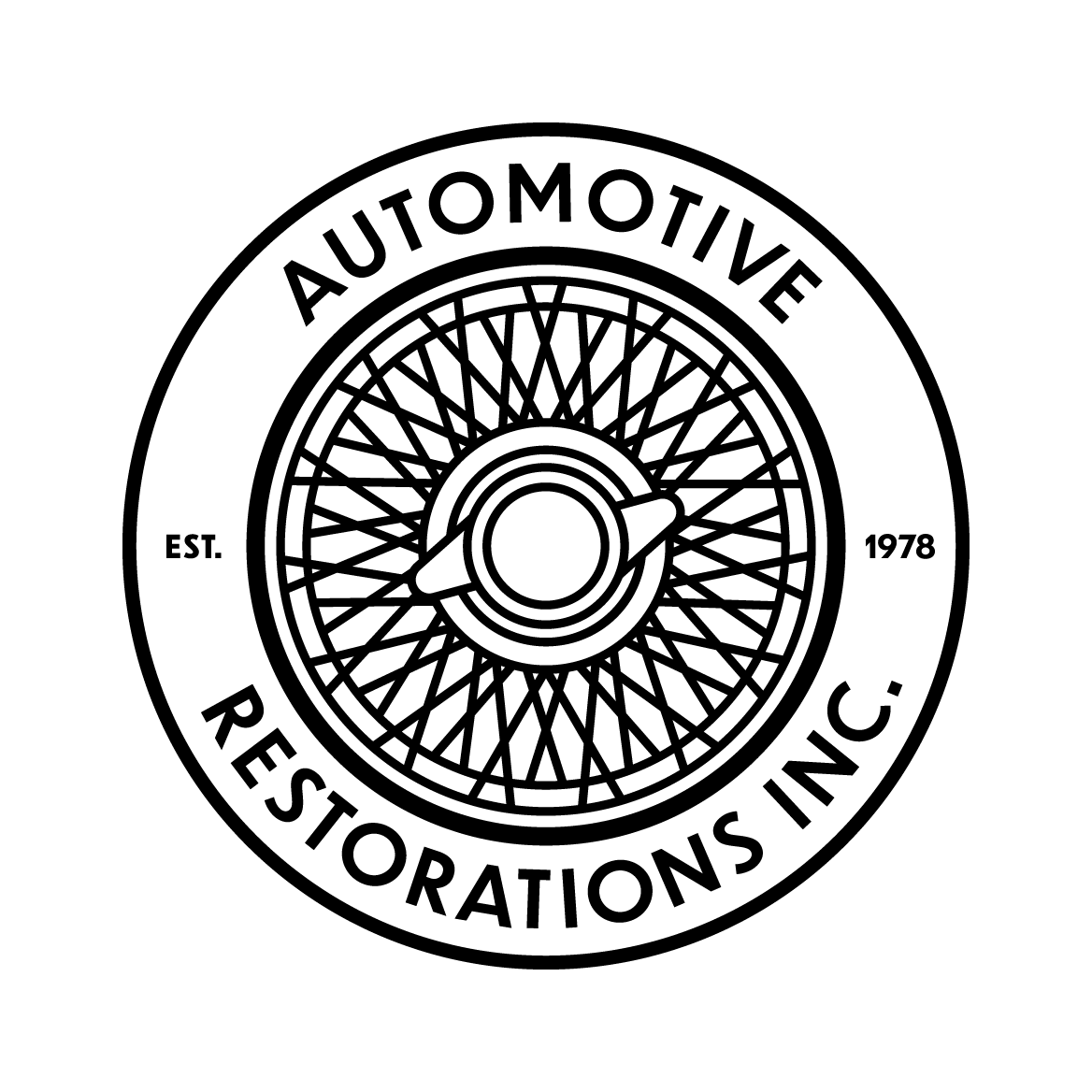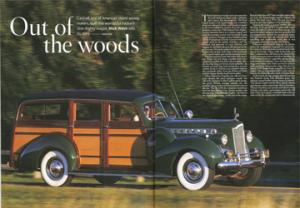Classic & Sports Car, Jul. 2005
Classic & Sports Car Magazine
Think American woody and most associate the half-timbered classic with California surf culture. But the image of a '40s Ford wagon loaded with beach bums, rear windows plastered with surf stickers and boards strapped to the roof couldn't be further from the stately presence of this rare 1940 Packard One-Eighty. Factory literature lists it as a 'station wagon' and that's the nostalgic picture this Inverness Green beauty conjures. Imagine chatty boarders piling off the Pennsylvania Pacific Exp[ress with huge school cases as the family chauffeur and big Packard wait patiently to carry children and luggage for the short trip up to the summer home in Vermont. Or maybe parked in the Adirondack backwoods, its rear deck laden with handmade rods, waxed weather gear and the morning's catch.
This Packard says hunt club rather than beach bar. When old and cheap, woodies were later adopted by surfers, but their role as a utility vehicle on a big estate or farm is more authentic. As homely as tartan rugs and roaring fires, no new country house in America was complete without the coachbuilt utility. Even the Prince of Wales and the Queen Mother had Ford woodies.
Other than a few bespoke one-offs on European chassis, the most exclusive woody was offered by Packard. Unlike Cadillac and Lincoln, the great Detroit marque smartly saw the medium-price marker as its best survival route in the late '30s. By 1940 the company's mainstays were the One-Ten and One-Twenty models, with the new One-Sixty and One-Eighty — the heirs to the Super 8 Series — at the top of the range. Rarest of this line of 4.7-litre straight-eight cruisers were the heavyweight station wagons. Of about 300 built from 1939-'40, just two were based on the One-Eighty's 127in wheelbase.
Tipping the scales at around 3800lb, this was the king of the pre-WW2 woodies with ample room for eight in a three-two-three set-up. The spacious leather-trimmed interior provided five accommodation options for guests and cargo. Cheaper models had ash frames with birch paneling and leatherette trim, but it was mahogany and leather for the One-Eighty.
Wherever the Packard went on ouor photoshoot, the enthusiastic response was universal — be it delivery driver in town or retired local walking on the beach. "They really looked like cars then," enthused the old-timer as he admired the proud cormorant mascot and deco detailing. By 1940 Packard had over-egged the ageing design with moulded headlamps, extra chrome 'catwalk' wing vents either side of the narrower radiator grille and flashy trims on the wings. But this 'six-wheel' 1939 design looks magnificent from all angels. Like co-respondent loafers with tailored tweeds, the whitewalls add a touch of Yankee flash.
At the wheel, this big, torquey sidevalve sweeps the Packard along with effortless grace, the exhaust a muted burble exiting a long way behind. The clutch is light and the three-speed column gearchange action surprisingly slick and positive. There's overdrive on second and third to help hid the wide ratios — particularly useful with a full load. Once up to speed, a red dash-light indicates time to lift the accelerator and it automatically engages overdrive. The smooth steering adds to the quality feel and its lock is amazing — even allowing a full 360º turn at a tight junction. With Packard's Safe-T-Flex independent front suspension and long, 51in semi-elliptics at the back, the ride is good with few creaks and graunches from the wooden body joints. The only limitation is the drum brakes. Coming down a long, steep mountain ridge road would take a trucker's skills with so much weight.
Packard station wagons were mostly built by two companies — Hercules in Evansville, Indiana and JT Cantrell & Company. The Long Island locations for this magnificent One-Eighty couldn't have been more appropriate. Cantrell, one of America's longest-standing makers of wood station wagon bodies was once based close to the rail tracks at Huntington, New York. Depressingly, in 1958, the company was bought out by a window maker, thus ending a coachbuilding tradition that started with a Model T in 1915.
Founder Joseph Cantrell was born in 1975 in Sunken Meadow. From an early age he was fascinated by woodworking right through to one of his last projects, a yacht made for his grandson in the '60s. Never much of a scholar, he dropped out of school early to start a long apprenticeship in local New Jersey carriage and boat-building shops before setting up on his own in 1905 when he bought a blacksmith and carriage shop in Huntington. Reputation soon spread along the East Coast about his quality carriages but, after WW1, the business was dying — partly hastened by the popularity of Henry Ford's Model T.
Following the advice of a customer, Cantrell and his brother Albert began designing and building car bodies. The first, based on a Model T, was the forerunner of the station wagon but was initially called a 'depot wagon'. Its design filled a void. The open-sided multi-seat vehicle was the logical choice for rural farmers who'd given up the buggy for a car but still needed something practical and rugged to transport people or goods into town. The depot wagon was an imediate success and the firm was flooded with orders. Initially bodywork was limited to Dodge and Ford chassis for locals but, by the mid-'20s, JT Cantrell & Company, Makers of Suburban Bodies had moved to new plants close to Huntington Station, with the advantage of a railroad siding to unload chassis direct from the factory. Cantrell's worst nighmare happened soon after when, one snowy night, the fully stocked factory caught fire and, fuelled by the stored wood, the business burnt to the ground because the blaze was too much for the local fire department.
Cantrell relaunched in a new factory built on the old site and, while building work progressed, Joseph set about producing new 'blueprint' designs on the latest Chevy, Ford and Dodge models. Salesmen then travelled through New Jersey, New York and Connecticut canvassing dealers. Back at the plant, construction focused on batches from each manufacturer rather than bespoke designs.
Chassis arrived at Huntington almost bodyless from the windshield rearward and frames were constructed of either rock maple or mahogany, with panels of white birch, mahogany or cottonwood. Rock maple later became a restorer's nightmare because it twists and warps with age. To prevent dry rot, fungus and insect attack, all wood sections were submerged in toxic wood primer and panels were extensively waterproofed.
Cantrell offered various levels of refinement for his range — sliding glass or roll-down windows, plus close-fitting rear curtain or lift-door tailgate depending on the customer's desires. The Deluxe Sedan featured Philippine mahogany frames whereas the basic Carryall had hard maple posts and ribs. As well as bodywork, the company upholstered interiors. Special features included removable rear seats to increase carrying capacity. Several of Cantrell's features were patented, including the 'safety tailboard fastener' which was made by a local metal fabricator.
The Depression years forced Cantrell & Co to turn away from assembly-line style construction and focus again on one-off orders. During WW2, the US War Department contracted Cantrell to convert sedans into station wagons. Often and existing car body would be cut in half and the chassis and driveshaft extended before a wood body was fitted. Once such conversion, in battleship grey, was shippped to the Pacific where it was used in the battle for the Caroline Islands.
With peace came prosperity for the Cantrells. Assembly-line construction returned with more than 100 employees turning out two doezen cars a day, mostly on Dodge or Chevrolet models. But automotive fashion and all-metal unitary body construction eventually turned the tide for the family-run business. By the late 1950s, orders had dried up with he arrival of mass-produced estate cars. Yet satisfied customers such as John Frieman of Islip, New York State proved how well-built Cantrell bodies were.
As a college student in 1938, Frieman drove his Dodge Cantrell out of the showroom and covered 113,000 miles over the next four decades — motoring through all the elements from heat waves to sub-zero weather, floods to hurricanes. As well as a daily commute into New York City, the Dodge ferried his 11 hounds to hunts and carried chicken manure from his father's farm. The only body repair was roof fabric replacement.
This Packard is fresh out of Automotive Restorations' workshop at Stratford in Connecticut where Kent Bain's team has rebuilt nearly 50 woodies since the business was founded in 1978. The company's experienced team of 'wood-centric' craftsmen started on the One-Eighty in autumn 2003. "The basic framework was strong," explains Bain. "Cantrell's simple design was well jointed and well conceived. As a result it hadn't loosened up like many tired wagons. This Packard had lived a tender life, probably on a big estate, so this was one of our more straightforward restorations. With the exception of the area around the rear wings, the design is pretty basic and compares with the work of rival Briggs. The jointing on this big body is simple half flaps which are well engineered but conservative.
"The trickiest bit was the mahogany curved rail used as a bolt flange for the rear fender. As long as you have a large enough piece of wood you can cut out anything you need."
Although the Cantrell body is coachbuilt on an exclusive Packard chassis, Bain reckons its construction is cruder than a Ford factory model: "These big wagons were really built for short journeys, maybe picking up guests from the station on a local hunting trip. The Packard would rarely be used for long trips or doing 80mph on the highway. Door fit is bad and it lets in the wind and rain against the worst weather. The sealing is really poor. A Ford station wagon is much better, with really well-worked-out angles and gutters."
With a super-deluxe heater the size of a dresser, the driver and passenger wouldn't have to worry about such draughts. As we motor home, the last strands of twilight reflecting off the long bonnet and high side spare cases, it's easy to see why coachbuilt woodies such as the Packard are so prized in America. But it's a car you'd soon get lonely in driving solo in the roomy cabin. Better to pack it full of friends and hide a CD player under the seat for a Benny Goodman soundtrack. Finding a Katharine Hepburn lookalike for a passenger might be more of a challenge, not to mention the outlay for period leather luggage. Samsonite cases and Nike trainers shouldn't be allowed in.



